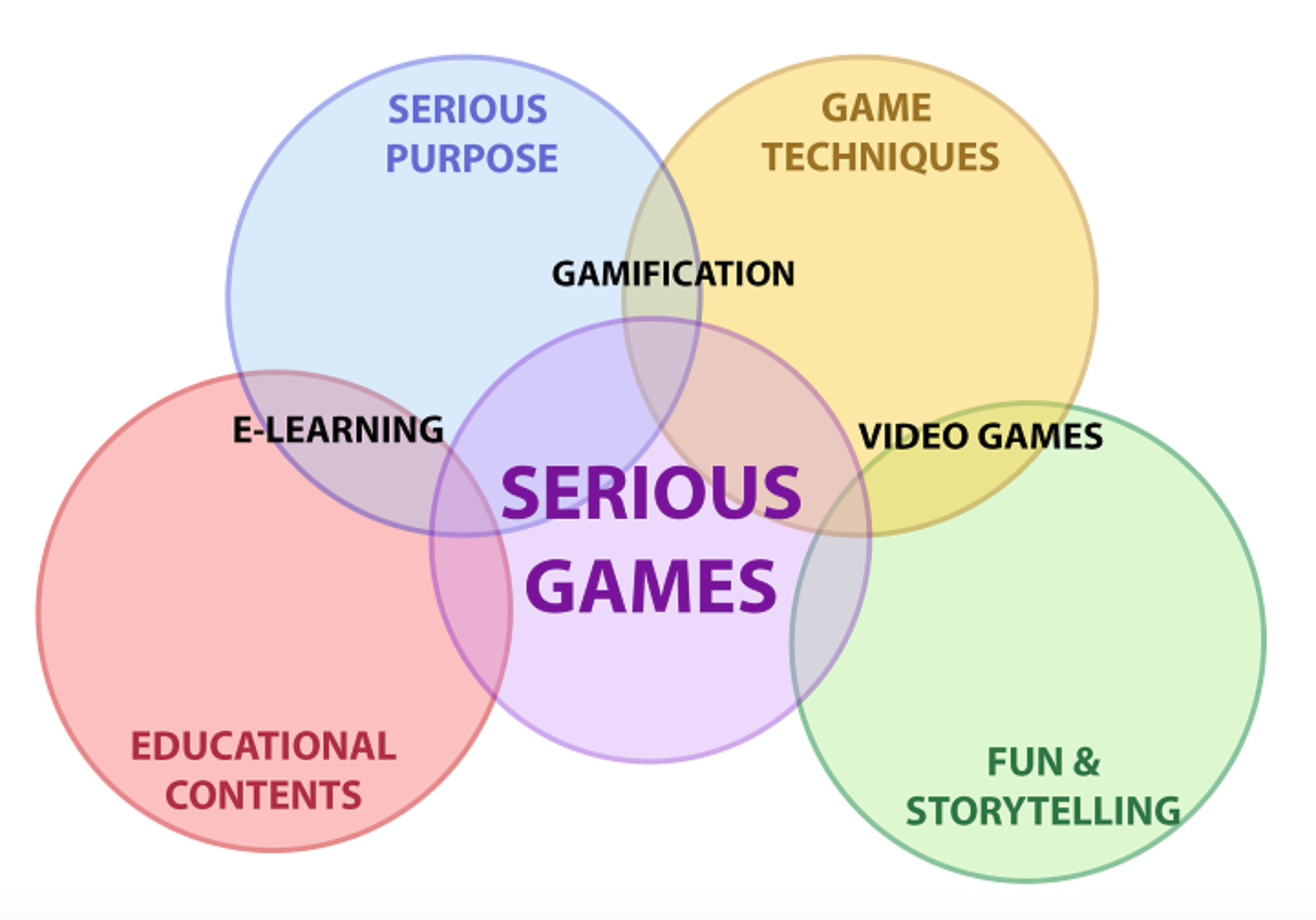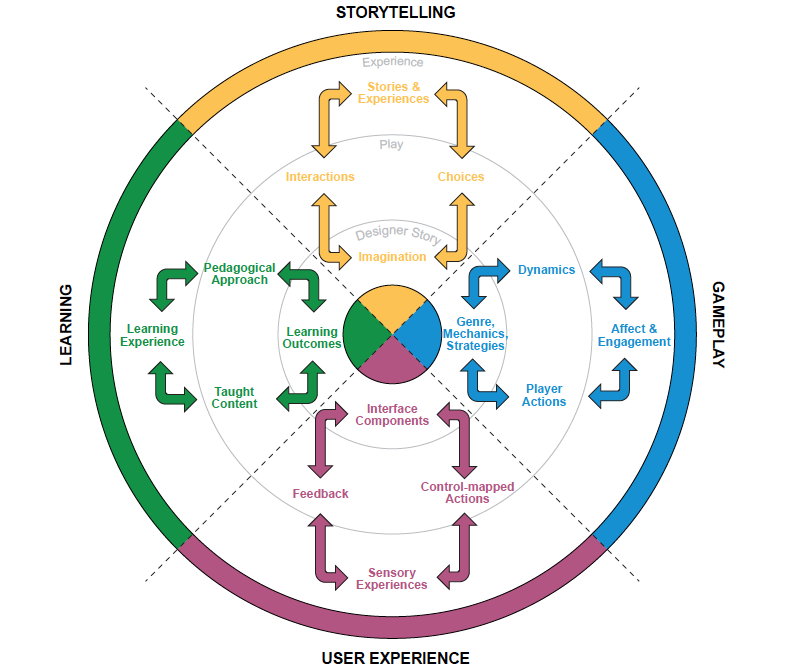69

Figure 9.2.1 The context of serious games. Image: Hydra Interactive, 2021
9.2.1 Serious games
Gartner’s hype cycle is best considered as a way of thinking about emerging technologies, rather than as a factual representation of their development. For instance, serious games are more of a slow burner. There have never been vastly inflated expectations about their likely impact on education; indeed for a long time they have been written off as too expensive or not appropriate for serious education. However, that view has been changing in recent years.
9.2.2 What are serious games?
There are several different definitions of serious games. I have included two definitions that cover both educational and corporate settings.
The Ministry of Education and Training, Victoria, Australia states (2017):
a serious game in an educational setting is considered to be a purposeful learning environment that targets key curriculum areas for explicit learning. Serious games are games or game-like interactive systems developed with game technology and design principles for a primary purpose other than pure entertainment.
Zhonggen (2019) provides this definition in his comprehensive review of the research on serious games:
Serious games are referred to as entertaining tools with a purpose of education, where players cultivate their knowledge and practice their skills through overcoming numerous hindrances during gaming.
It is important to distinguish between serious games, game-based learning and gamification because of the differences in their purpose, approach and impact on learning.
- Game-based learning refers to “the pedagogical approach of utilizing games in education” (Anastasiadis, Lampropoulos and Siakas, 2018)
- Gamification is defined as the “use of game design elements in non-game contexts” (Deterding et al., 2011)
Note that serious games are not necessarily digital. However, whether digital or not, they are governed by similar principles of of design, such as mechanics, dynamics and aesthetics (Hunicke et al., 2004).
9.2.3 Why use serious games?
The main reasons offered for using games in education are to:
- improve students’ motivation to learn,
- engage learners more deeply in the learning process,
- improve learning outcomes,
- improve attendance and participation.
However, an extensive review of the literature conducted by Dichev and Dicheva in 2017 found that research remains inconclusive on these assumptions. They also found that:
- the practice of gamifying learning has outpaced researchers’ understanding of its mechanisms and methods;
- insufficient high quality evidence exists to support the long-term benefits of serious games in an educational context;
- a limited understanding that how to gamify an activity depends on the specifics of the educational context.
Dichev and Dicheva do conclude though that their study does not mean that gamification cannot be used successfully in a learning context; rather better designs and more research are needed.
Other research tends to be more positive. Hamari et al. (2016) and Clark et al. (2016) found sufficient evidence that, when well designed, and under the right conditions, serious games significantly enhanced student learning relative to nongame conditions.
Zhonggen (2019) found among the ‘ huge number of findings in serious game assisted learning, most …are supportive, coupled with a few negative results.’ However, the main benefits tended to be in the affective domain (student ‘happiness’ and improved social learning and communication) rather than in immediately improved cognitive learning outcomes, except in science (improved retention and holistic understanding), architecture and medicine/health. In the latter, games helped children with autism to learn. Zhonggen reports:
‘Generally, … medical science has recently witnessed clearly more studies on serious game assisted learning compared with other fields and most of studies in medical science supported use of serious games.’
9.2.4 Examples of serious games
The Digital Education Strategies team (DES) at Toronto Metropolitan University (formerly Ryerson University) has participated in the development of several virtual games simulations including:
Games-based learning: Toronto Metropolitan University‘s Academic Integrity office, in collaboration with DES, developed a digital learning game called Academic Integrity in Space to motivate students to complete self-study training and to learn about the academic integrity, values and behaviours expected of students. The game development team’s objectives were to create a well-designed digital game to meet the learning objectives of making choices, learning by doing, and experiencing situations first-hand, through role-playing.

Video Game Simulation: A Home Visit game promotes the application of knowledge and skills related to establishing a therapeutic nurse-client relationship and completing a mental health assessment. Students assume the role of a community health nurse assigned to complete a home visit. Video is used to create an authentic experience, and students have to respond to particularly challenging situations, based on procedures taught elsewhere in the course. Depending on the student response, further video segments are used to provide feedback and to continue to scenarios to test the next appropriate procedure.

Instructors from Centennial College, Toronto Metropolitan University and George Brown College have developed a series of open access video game simulations through a virtual healthcare experience portal.

Gamification: Kyle Geske, an instructor at Red River College, Winnipeg, has developed a games-based approach to teaching web design. In his elective course on Full Stack Development of web sites, students have to design a project according to principles provided by the instructor. At each stage of the design process within the project students gain marks, and compete throughout the course with other students, who can see the marks at each stage for all the other students. A student can ‘level up’ their mark by going back and improving on each of the steps of the design. This approach has resulted in an increase in the average end of course grade compared to the more traditional classroom methods. Note this course involves elements of gaming, such as competition, and ‘levelling up’, without using games themselves.
9.2.5 Designing serious games
Zhonggen’s review of the literature (2019) highlighted the importance of the following in effective games design:
-
backstory and production,
-
realism,
-
artificial intelligence and adaptivity,
-
interaction,
-
feedback and debriefing,
-
ease of use,
-
surprises.
Building on prior research, and under the leadership of Naza Djafarova, the Digital Education Strategies team (DES) at the G. Raymond Chang School for Continuing Education at Toronto Metropolitan University developed a practical design guide for serious game-based learning, based on a games research process. This guide is an open educational resource and is designed to serve three purposes:
- provide a conceptual framework to guide game design within multidisciplinary teams in higher education;
- offer a methodological guide to running a participatory workshop focused on the pre-production phase of the game development process;
- share resources by making the guide and the design of the workshop available as open educational resources.
The games design methodology is an adaptation of the Design, Play, and Experience (DPE) Framework, developed by Winn (2009). The game development process consists of three phases:
- the pre-production phase, during which brainstorming among team members takes place, leading to the design of a paper prototype of the game;
- the production phase, when the game is developed; and
- the post-production phase, during which the game is tested and refined before being offered to learners.
The Digital Education Strategies team utilized the Design, Play and Experience model to identify four essential educational game elements:
- Learning refers to the content to be learned by players through the game with specific and measurable learning outcomes;
- Storytelling refers to the background story of the game and includes a description of the character(s), the setting, and the ultimate goal of the game;
- Gameplay refers to the way in which the player interacts with the game, or with other players (if a multiplayer game). It encapsulates the type of activity (e.g., puzzle, trivia, etc.) found in the game;
- User Experience refers to the player’s emotions and attitudes while playing the game, as well as how the player interacts with the game.
Figure 9.2.5 provides a more detailed representation of the various components of the Ryerson serious game design methodology.

The Digital Education Strategies’ report suggests a workshop approach to serious games design, in which all the key stakeholders (content experts, instructional designers, media producers, and so forth) are involved. Brainstorming in the early stages of design is considered essential. Also built into the design is testing and user feedback before releasing the game.
There are probably other effective design approaches, but the above approach highlights the essential multi-disciplinary approach of serious games design.
9.2.6 Unique educational characteristics of serious games
These still need to be clearly identified and validated, but two rather different claims are made for serious games:
- the first is that they can increase student motivation and engagement;
- the second is that games can be particularly useful for developing the following skills:
- problem solving
- communication skills
- decision-making
within specific contexts that approximate to the real world.
9.2.7 Strengths and weaknesses
In terms of the hype cycle, serious games are somewhere along the slope of enlightenment. There is not the research yet to move them into the plateau of productivity, but there is enough evidence from practice that they are gaining traction in education.
However, there are a number of reasons why serious games have not become more prevalent in education. The first is philosophical. There is resistance to the idea of games because some see serious games as an oxymoron. How can a game be serious? Many instructors fear that learning could easily be trivialised through games or that games can cover only a very limited part of what learning should be about – it can’t all be fun; that is not the purpose of education. Similarly, many professional game designers are not interested in developing serious games because they fear that if the primary goal is learning and not enjoyment, a focus on education risks killing the main element of a game: being fun to play.
A more pragmatic reason is cost and quality. The assumed high cost of video games has so far acted as a deterrent in education. There is no obvious business plan to justify the investment. The best selling video games for entertainment for instance cost millions of dollars to produce, on a scale similar to mainstream movies. If games are produced cheaply, won’t the quality – in terms of production standards, narrative/plot, visuals, and learner engagement – suffer, thus making them unattractive for learners?
However, probably the main reason serious games are not more prevalent in education is that most educators simply do not know enough about serious games: what exists, how they can be used, nor how to design them. Experience suggests that there are many possible and realistic applications for serious games in education. There is some evidence (see for instance, Arnab, 2014) that effective serious games can be developed at very little cost.
Nevertheless, there is always a high degree of risk in serious games design. There is no sure way of predicting in advance that a new game will be successful. Some low-cost simple games can work well; some expensively produced games can easily flop. This means careful testing and feedback during development. So serious games should be more seriously considered for teaching in a digital age – but their application needs to be done carefully and professionally.
Thus serious games are a relatively high risk, high return activity for teaching in a digital age. Success in serious games means building on best practices in games design, both within and outside education, sharing costs and experience, and collaboration between institutions and games development teams. However, as teaching in a digital age moves more and more towards high-level skills development, experiential learning, and problem-solving in real world contexts, serious games are bound to play an increasingly important role.
References
Anastasiadis, T. et al. (2018) Digital Game-based Learning and Serious Games in Education International Journal of Advances in Scientific Research and Engineering, Vol. 4, No. 12
Arnab, S. et al. (2014) Mapping learning and game mechanics for serious games analysis. British Journal of Educational Technology, Vol. 46, No. 2, pp 391–411
Clark, D. et al. (2016) Digital Games, Design, and Learning: A Systematic Review and Meta-Analysis Review of Educational Research, Vol. 86, No. 1
Deterding, S. et al. (2011) Gamification: Using Game Design Elements in Non-Gaming Contexts in PART 2-Proceedings of the 2011 annual conference extended abstracts on Human Factors in Computing Systems Vancouver BC: CHI
Dichev, C. and Dicheva Computers in Human D. (2017) Gamifying education: what is known, what is believed and what remains uncertain: a critical review International Journal of Educational Technology in Higher Education, Vol. 14, No. 9
Djafarova, N. et el. (2018) The Art of Serious Game Design Toronto ON: Chang School of Continuing Studies, Ryerson University
Hamari, J., et al. (2016) Challenging games help students learn: An empirical study on engagement, flow and immersion in game-based learning Computers in Human Behavior, Vol. 54
Hunicke, R., LeBlanc, M., & Zubek, R. (2004). MDA: A formal approach to game design and game research, in Proceedings of the Challenges in Game AI Workshop, San Jose CA: Nineteenth National Conference on Artificial Intelligence
Winn, B. (2009) ‘The design, play and experience framework’, in R. Ferdig (Ed.), Handbook of research on effective electronic gaming in education. Hershey, PA: IGI Global (pp. 388–401).
Zhonggen, Y. (2019) A Meta-Analysis of Use of Serious Games in Education over a Decade, International Journal of Computer Games Technology, vol. 2019, Article ID 4797032
Activity 9.2 Using and designing serious games
- What are your views on serious games and gamification? Do you think they are useful approaches to teaching in a digital age, or are they just a gimmick that avoids the real challenges of learning, especially at a higher education level?
- Take a look at the Toronto Metropolitan University’s ‘Art of Serious Games Design’. Is this a model that could be used at your institution? Who would lead this effort? With what learning goals or outcomes could this process help in your program? What would be the main barrier to doing this?
- What other approaches could be taken to getting serious games used in your teaching?
Click on the podcast below for feedback on this activity.

